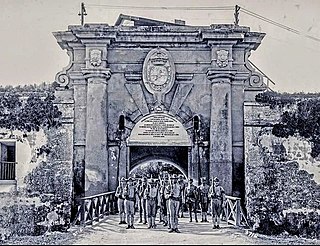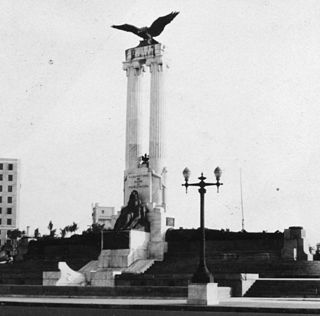
Havana is the capital and largest city of Cuba. The heart of the La Habana Province, Havana is the country's main port and commercial center. The city has a population of 2.3 million inhabitants, and it spans a total of 728.26 km2 (281.18 sq mi) for the capital city side and 8,475.57 km² for the metropolitan zone – making it the largest city by area, the most populous city, and the second largest metropolitan area in the Caribbean region.

Maine was a United States Navy ship that sank in Havana Harbor on February 15, 1898, contributing to the outbreak of the Spanish–American War in April. U.S. newspapers, engaging in yellow journalism to boost circulation, claimed that the Spanish were responsible for the ship's destruction. The phrase, "Remember the Maine! To hell with Spain!" became a rallying cry for action. Although the Maine explosion was not a direct cause, it served as a catalyst that accelerated the events leading up to the war.

Regla is one of the 15 municipalities or boroughs in the city of Havana, Cuba. It comprises the town of Regla, located at the bottom of Havana Bay in a former aborigine settlement named Guaicanamar, Loma Modelo in a peninsula dividing Marimelena from Guasabacoa inlets, and the village of Casablanca located at the entry of the Havana Bay.

Morro Castle or Castle of the Three Magi Kings of Morro, named after the three biblical Magi, is a fortress guarding the entrance to the Havana harbor. The design is by the Italian engineer Battista Antonelli (1547–1616). Originally under the control of Spain, the fortress was captured by the British in 1762, returned to Spain under the Treaty of Paris (1763) a year later. The Morro Castle was the main defense in the Havana harbor until La Cabaña was completed in 1774.

Fortaleza de San Carlos de la Cabaña, colloquially known as La Cabaña, is an 18th-century fortress complex, the third-largest in the Americas, located on the elevated eastern side of the harbor entrance in Havana, Cuba. The fort rises above the 60-meter (200 ft) hilltop, along with Morro Castle. The fort is part of the Old Havana World Heritage Site which was created in 1982.

The Cuban War of Independence, also known in Cuba as The Necessary War, fought from 1895 to 1898, was the last of three liberation wars that Cuba fought against Spain, the other two being the Ten Years' War (1868–1878) and the Little War (1879–1880). The final three months of the conflict escalated to become the Spanish–American War, with United States forces being deployed in Cuba, Puerto Rico, and the Philippine Islands against Spain. Historians disagree as to the extent that United States officials were motivated to intervene for humanitarian reasons but agree that yellow journalism exaggerated atrocities attributed to Spanish forces against Cuban civilians.

Old Havana is the city-center (downtown) and one of the 15 municipalities forming Havana, Cuba. It has the second highest population density in the city and contains the core of the original city of Havana. The positions of the original Havana city walls are the modern boundaries of Old Havana.
Cuban infrastructure is significant and includes: massive Spanish fortifications built in principal ports.
City of Washington was an American merchant steamship that aided in rescuing the crew of USS Maine when it exploded in the harbor of Havana, Cuba, in 1898.

The Castillo de la Real Fuerza is a bastion fort on the western side of the harbour in Havana, Cuba, set back from the entrance, and bordering the Plaza de Armas. Originally built to defend against attack by pirates, it suffered from a poor location; it was too far inside the bay. The fort is considered to be the oldest stone fort in the Americas, and was listed in 1982 as part of the UNESCO World Heritage Site of "Old Havana and its Fortifications".

Castillo San Salvador de la Punta is a fortress at the entrance to the bay in Havana, Cuba.

The Christ of Havana is a large sculpture representing Jesus of Nazareth, on a hilltop overlooking the bay in Havana, Cuba. It is the work of the Cuban sculptor Jilma Madera, who won the commission for it in 1953.

The siege of Havana was a successful British siege against Spanish-ruled Havana that lasted from March to August 1762, as part of the Seven Years' War. After Spain abandoned its former policy of neutrality by signing the family compact with France, resulting in a British declaration of war on Spain in January 1762, the British government decided to mount an attack on the important Spanish fortress and naval base of Havana, with the intention of weakening the Spanish presence in the Caribbean and improving the security of its own North American colonies. A strong British naval force consisting of squadrons from Britain and the West Indies, and the military force of British and American troops it convoyed, were able to approach Havana from a direction that neither the Spanish governor nor the Admiral expected and were able to trap the Spanish fleet in the Havana harbour and land its troops with relatively little resistance.

Alfonso XII, was an Alfonso XII-class unprotected cruiser of the Spanish Navy.

The Captaincy General of Cuba was an administrative district of the Spanish Empire created in 1607 as part of Habsburg Spain attempt to better defend and administer its Caribbean possessions. The reform also established captaincies general in Puerto Rico, Guatemala and Yucatán.

Havana was founded in the sixteenth century displacing Santiago de Cuba as the island's most important city when it became a major port for Atlantic shipping, particularly the Spanish treasure fleet.

Water pollution in the United States is a growing problem that became critical in the 19th century with the development of mechanized agriculture, mining, and industry, although laws and regulations introduced in the late 20th century have improved water quality in many water bodies. Extensive industrialization and rapid urban growth exacerbated water pollution as a lack of regulation allowed for discharges of sewage, toxic chemicals, nutrients and other pollutants into surface water.

The Monument to the Victims of the USS Maine was built in 1925 on the Malecón boulevard at the end of Línea Calle, in the Vedado neighborhood of Havana, Cuba.

The Castillo del Príncipe is a military fort located in the Loma de Aróstegui, in Havana, Cuba. In 1982, the fort was inscribed on the UNESCO World Heritage List, along with other historic sites in Old Havana, because of the city's importance in the European conquest of the New World, its fortifications, and its unique architecture.

The Royal Arsenal of Havana was located South East of the Campo de Marte and played a prominent role in Spanish shipbuilding in the 18th century. In total, seventy-four warships were built in Havana during this century.























